Let me share one of my family's favorite twists on a Bicolano classic.
Growing up in a household where spicy food was a staple, I never thought I'd find a Bicol Express version that could match my Lola's legendary pork recipe, until I started making it with chicken.
As a busy mom always looking for healthier options without sacrificing flavor, this Chicken Bicol Express has become my go-to version that even my spice-loving relatives request during family gatherings.
The magic lies in how the tender chicken pieces soak up that creamy coconut sauce, while the combination of siling labuyo and siling haba brings that signature Bicolano heat that we all crave. It's so much lighter than the traditional pork version, but still packs that same punch of flavors.
Perfect for those of us who want to enjoy our favorite comfort food with a bit less guilt, this recipe takes just 50 minutes from prep to table.
What is Chicken Bicol Express?
Chicken Bicol Express is a modern interpretation of a beloved Bicolano dish where tender chicken pieces replace traditional pork, simmered in a luscious coconut cream sauce infused with aromatic shrimp paste and two varieties of chili peppers. This healthier adaptation maintains the signature creamy-spicy flavor profile that made the original dish famous while offering a quicker-cooking, more economical option that's equally satisfying served over steaming rice.
Jump to:
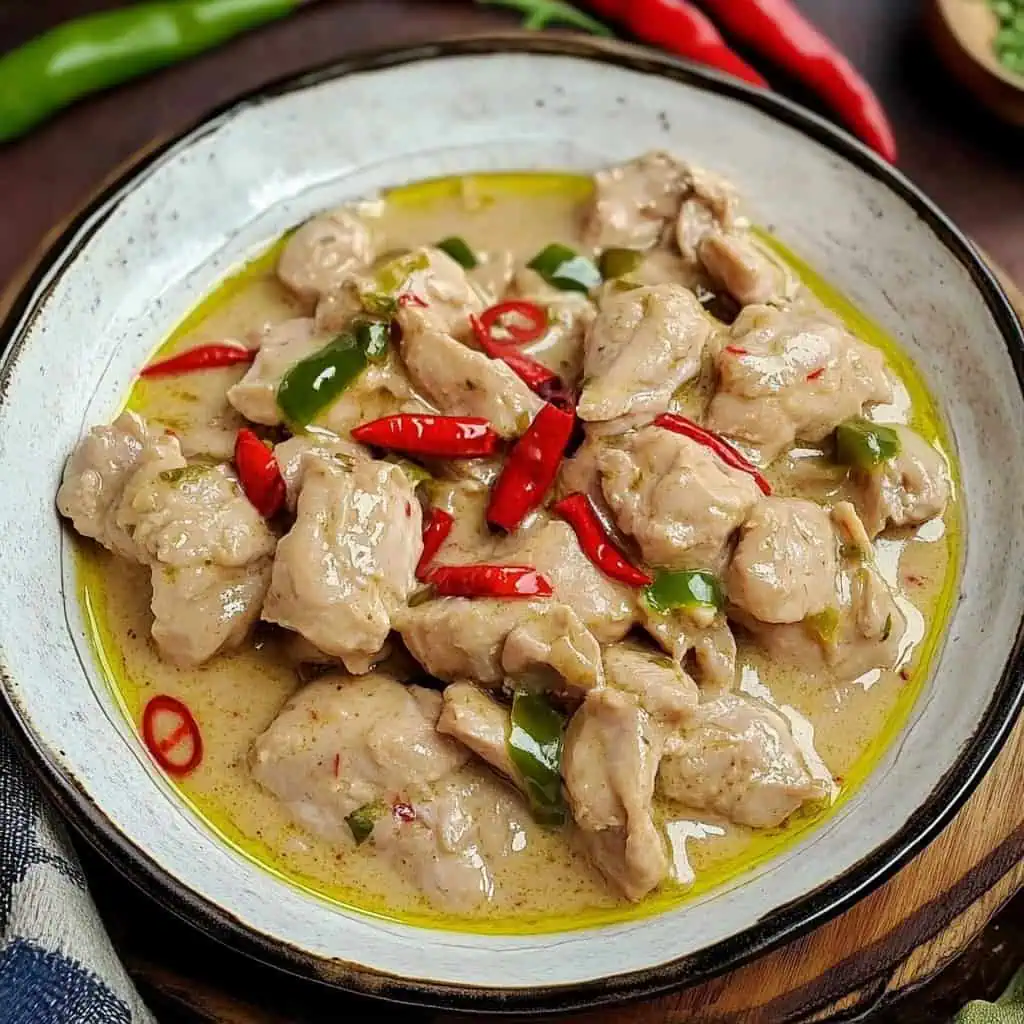
Why You'll Love This Recipe
- Healthier Alternative: Lower in fat compared to the traditional pork version
- Budget-Friendly: Chicken is more economical than pork belly
- Quick-Cooking: Ready in under an hour
- Adjustable Heat Level: Easy to customize spiciness
- One-Pan Meal: Minimal cleanup required
- Rich and Creamy: Perfect sauce-to-meat ratio
Ingredients
The ingredients in this Chicken Bicol Express create a beautiful balance of flavors and textures that defines authentic Filipino cooking. Chicken thighs provide a tender, juicy base that absorbs flavors better than other cuts.
Coconut cream delivers the signature rich creaminess that smooths out the heat, while the combination of two chili varieties (Thai and finger chilies) offers complex spiciness with different intensity levels. Shrimp paste adds that essential umami depth that can't be replicated, while fresh aromatics like ginger, garlic, and onions create a fragrant foundation.
Together, these ingredients honor the traditional Bicolano flavor profile while making the dish lighter and more accessible for everyday cooking.
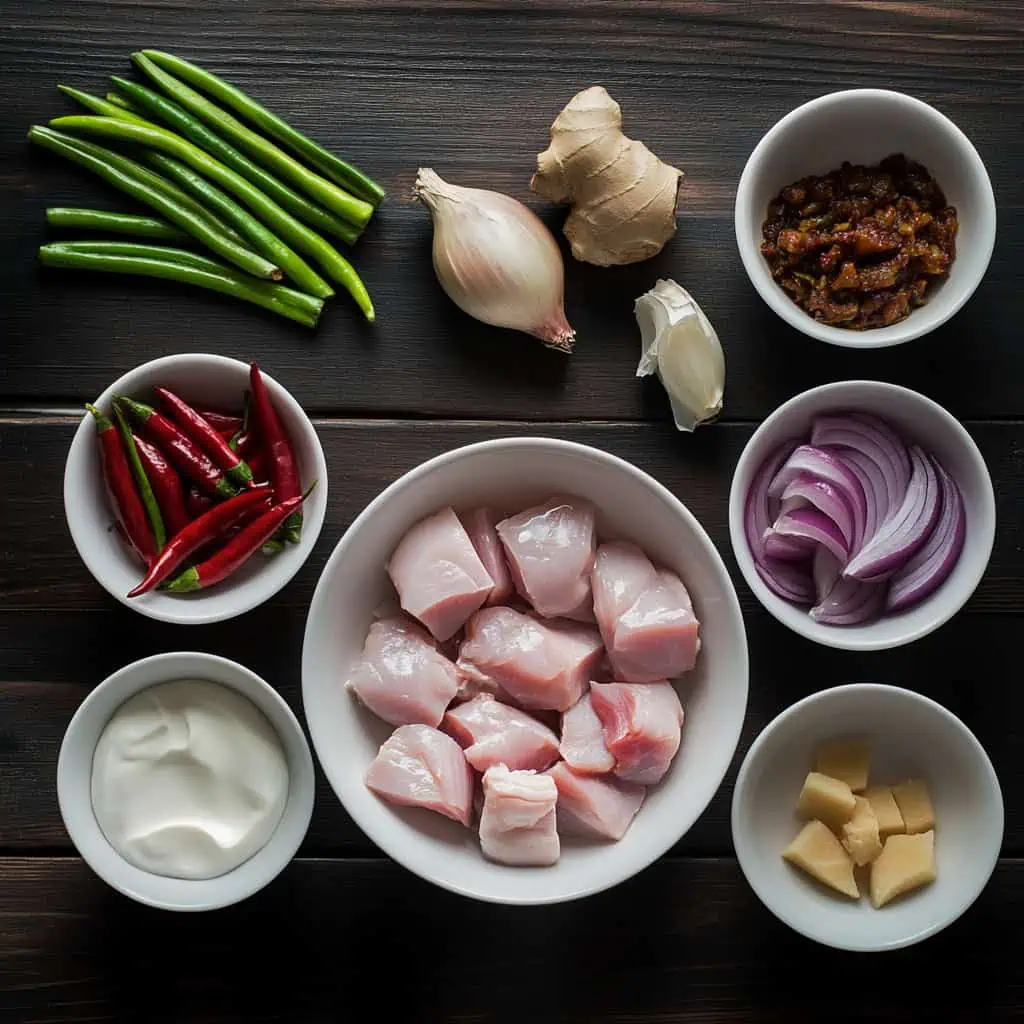
- 2 pounds boneless skinless chicken thigh, cut into 1-inch cubes
- 1 can (14 oz) coconut cream (kakang gata)
- 1 onion, peeled and chopped
- 4 cloves garlic, peeled and minced
- 1 thumb-size ginger, peeled and minced
- 1 tablespoon sauteed shrimp paste (ginisang bagoong)
- 10 pieces Thai chili peppers (siling labuyo), stemmed and minced
- 2 cups finger chilies (siling haba), sliced
- 1 tablespoon cooking oil
- Salt and pepper to taste
Equipment
- Large deep skillet or kawali: For even heat distribution and enough space to simmer the dish properly
- Sharp knife and cutting board: Essential for cutting chicken into uniform pieces for even cooking
- Measuring cups and spoons: To ensure balanced flavors in your dish
- Wooden spoon or spatula: Helps stir without breaking up the coconut cream emulsion
- Can opener: For accessing the coconut cream
- Food thermometer: Ensures chicken reaches the safe internal temperature of 165°F (74°C)
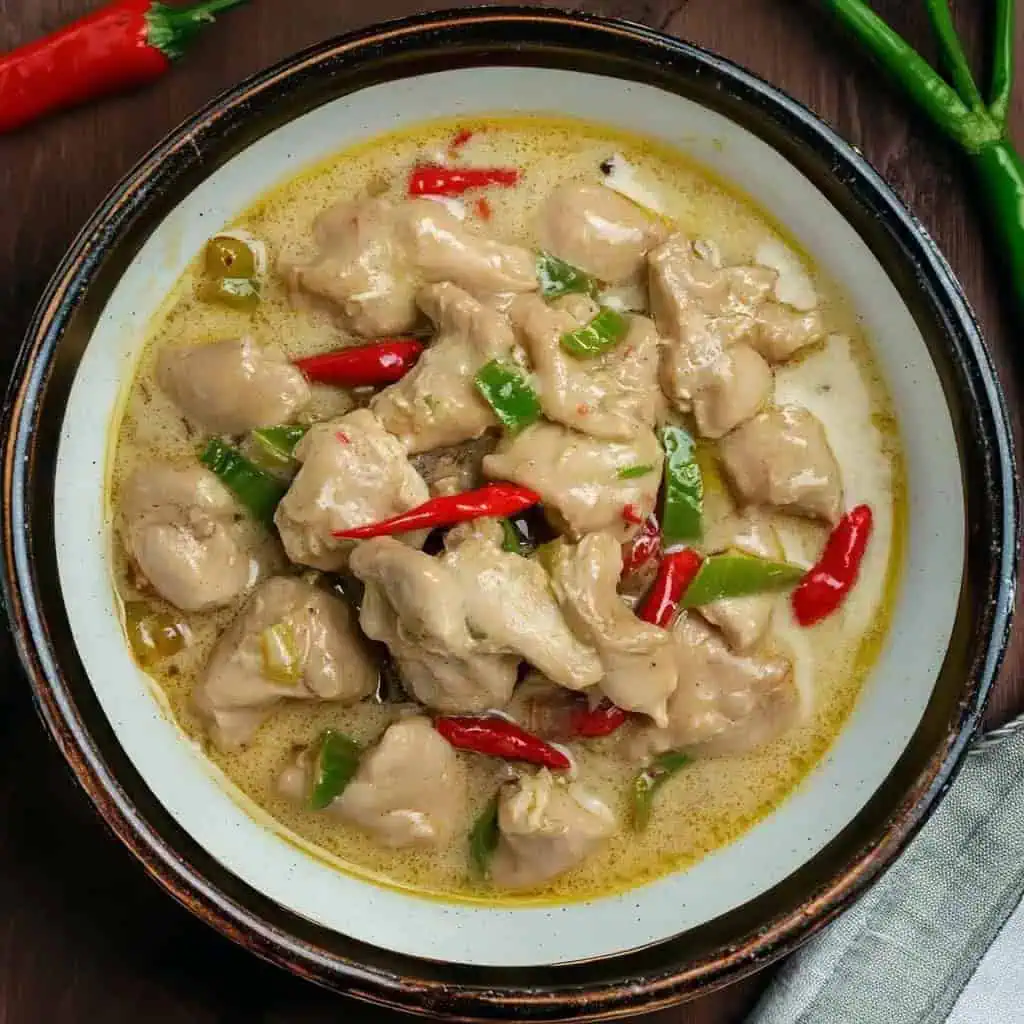
How To Make
- Prepare your ingredients: Cut chicken thighs into 1-inch cubes, ensuring they're uniform in size for even cooking. Mince your garlic, ginger, and onions. Remove stems from Thai chili peppers and slice your finger chilies.
- Sauté aromatics: Heat oil in a deep pan over medium heat. Add minced garlic, ginger, and onions. Cook until the onions become translucent and fragrant, about 3-4 minutes.
- Brown the chicken: Add chicken pieces to the pan. Cook until they turn light brown, stirring occasionally for 8-10 minutes.
- Add shrimp paste: Incorporate the shrimp paste, stirring for 1-2 minutes to evenly coat all chicken pieces.
- Simmer with coconut cream: Pour in coconut cream and add Thai chili peppers. Keep heat at medium-low so the sauce gently simmers but never boils rapidly, which would cause the coconut cream to separate.
- Cook thoroughly: Cover the pan and let everything cook gently for 20-25 minutes. Chicken is done when no pink remains inside.
- Finish with fresh chilies: Add sliced finger chilies and cook for 2-3 more minutes, just until slightly softened. Taste and adjust salt and pepper as needed.
- Rest before serving: Allow the dish to rest for a few minutes. The sauce will thicken slightly as it cools. Serve hot with plenty of rice.

Tips from Lola's Kitchen
- Toast your aromatics properly: Taking an extra 2-3 minutes to properly sauté garlic, ginger, and onions releases their essential oils and creates a flavor foundation for the dish.
- Choose chicken thighs over breast: Thigh meat stays juicy and tender throughout the cooking process, whereas breast meat can become dry.
- Control the heat gently: The secret to silky-smooth coconut cream sauce is gentle heat—never let it boil rapidly.
- Cut uniform pieces: Equal-sized chicken pieces ensure everything cooks at the same rate.
- Season in layers: Add salt gradually throughout cooking rather than all at once at the end.
- Rest before serving: Allowing the dish to rest for 5 minutes helps flavors meld and sauce thicken.
- Use first press coconut cream (kakang gata) for maximum creaminess and flavor.
Substitutions
- Protein alternatives: Substitute chicken breast if you prefer (reduce cooking time by 5 minutes), or use firm tofu for a vegetarian version.
- Coconut cream alternatives: Regular coconut milk works but produces a thinner sauce; reduce by simmering longer.
- Chili alternatives: Bell peppers provide flavor without heat; jalapeños offer moderate spice; bird's eye chilies can replace Thai chilies.
- Shrimp paste alternatives: Fish sauce (patis) works well, though the flavor profile will change slightly. Start with 1 tablespoon and adjust to taste.
- Aromatics: Shallots can replace onions for a milder, sweeter flavor.
Troubleshooting
- Sauce too thin?: Simmer uncovered for 5-7 minutes to reduce, or add 1 tablespoon more kakang gata.
- Too spicy?: Add an additional ¼ cup coconut cream to mellow the heat, or serve with extra rice and cucumber slices.
- Sauce separating or curdling?: Lower heat immediately, transfer to a cooler part of the pan, and stir gently but constantly while simmering.
- Chicken too tough?: The meat likely cooked too quickly at high heat. Next time, ensure medium-low heat and gentle simmering.
- Not flavorful enough?: Add ½ teaspoon more bagoong and a pinch of salt. Allow flavors to meld for 5 more minutes.
Storage & Reheating
- Refrigeration: Store in an airtight container for up to 3 days. The flavors actually improve overnight as the spices meld with the coconut cream.
- Freezing: Can be frozen for up to 2 months in a freezer-safe container. Thaw overnight in the refrigerator before reheating.
- Reheating: Warm gently on the stovetop over medium-low heat, stirring occasionally. Add a splash of coconut milk if the sauce has thickened too much. Avoid microwave reheating which can make the sauce separate.
- Portion storage: Consider freezing in meal-sized portions for quick weeknight dinners.
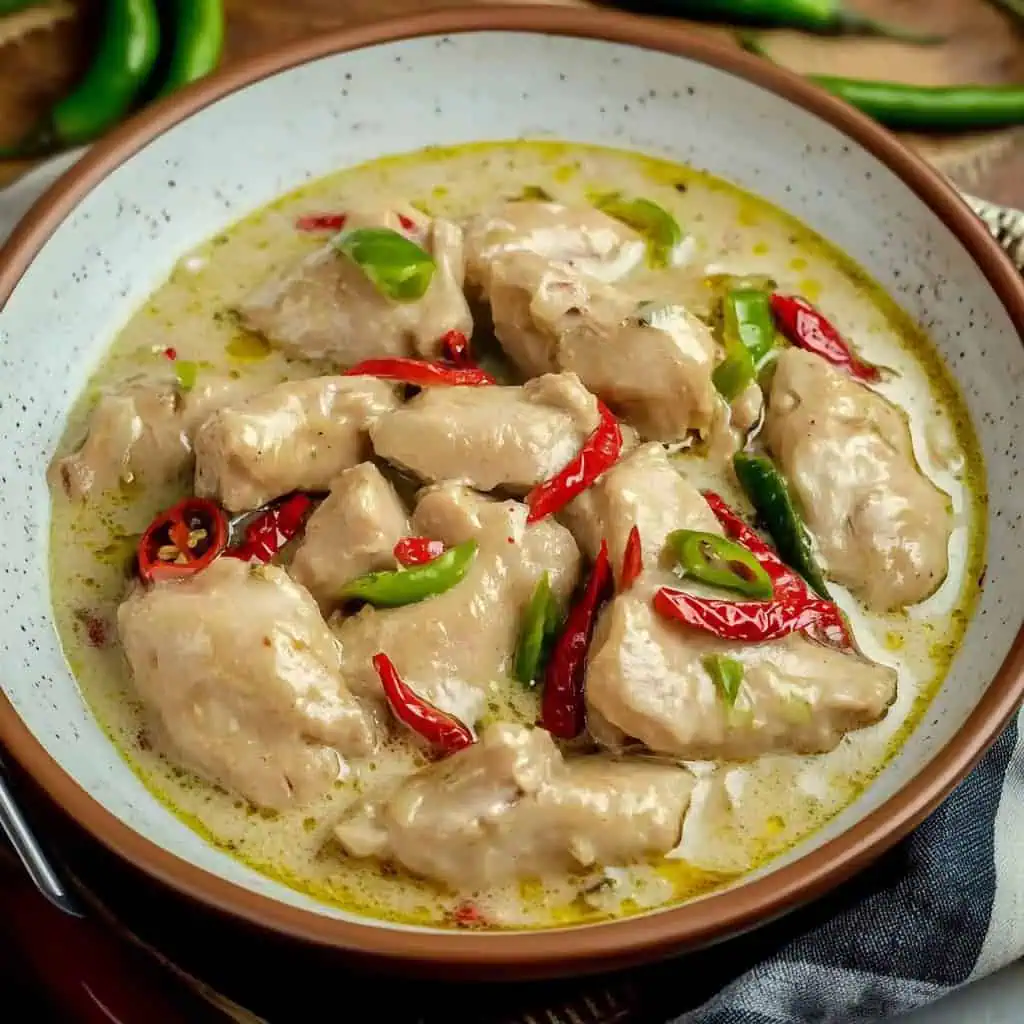
FAQ
Can I make this dish in advance for parties?
Yes! In fact, the flavors develop beautifully overnight. Make it a day ahead, refrigerate, and gently reheat before serving.
How do I adjust the spiciness for different preferences?
For milder heat, remove seeds from the chilies or reduce the quantity by half. For extra spicy, increase Thai chili peppers by 50%. Always have extra chilies on the side for heat-lovers to add to their portions.
Why are chicken thighs recommended over breast meat?
Thigh meat has more fat and collagen, making it more forgiving during the cooking process. It stays tender and juicy even with extended cooking, unlike breast meat which can become dry.
Is this an authentic Bicolano recipe?
This is a modern adaptation that maintains the core flavors of traditional Bicol Express while using a healthier protein alternative. The flavor profile with coconut cream, shrimp paste, and chilies honors the Bicolano culinary tradition.
Can I use a slow cooker for this recipe?
Yes! Sauté the aromatics and brown the chicken first, then transfer to a slow cooker with remaining ingredients. Cook on low for 4 hours or high for 2 hours, adding the finger chilies during the last 30 minutes.
What sides pair well with Chicken Bicol Express?
Traditional accompaniments include hot steamed rice, grilled eggplant salad (ensaladang talong), fried plantains (pritong saging), or fresh green mango slices on the side to balance the heat.
Can I use frozen chicken for this recipe?
For best results, thaw chicken completely before cooking. Pat dry with paper towels to ensure proper browning, which adds significant flavor to the finished dish.
Related
Looking for other recipes like this? Try these:

Chicken Bicol Express (Manok na Bicol Express)
Equipment
- Large deep skillet or kawali (Traditional Filipino wok) For even heat distribution
- Sharp knife and cutting board For preparing ingredients
- Measuring cups and spoons For accurate measurements
- Wooden spoon or spatula For sautéing and stirring
- Can opener For coconut cream
- Food thermometer To ensure chicken is properly cooked
Ingredients
- 2 pounds boneless skinless chicken thigh (manok na hita), cut into 1-inch cubes
- 1 can 14 oz coconut cream (kakang gata)
- 1 onion sibuyas, peeled and chopped
- 4 cloves garlic bawang, peeled and minced
- 1 thumb-size ginger luya, peeled and minced
- 1 tablespoon sauteed shrimp paste ginisang bagoong
- 10 pieces Thai chili peppers siling labuyo, stemmed and minced
- 2 cups finger chilies siling haba, sliced
- 1 tablespoon cooking oil
- Salt asin and pepper (paminta) to taste
Instructions
- Before starting, cut your chicken thighs into 1-inch cubes. Make sure they're all about the same size so they cook evenly. Mince your garlic, ginger, and onions. Remove stems from Thai chili peppers and slice your finger chilies.
- Heat oil in a deep pan over medium heat. Add your minced garlic, ginger, and onions. Cook until the onions become clear and you can smell the garlic, about 3-4 minutes.
- Put in your chicken pieces. Let them cook until they turn light brown, stirring every now and then. This takes about 8-10 minutes.
- Add the shrimp paste. Keep stirring for 1-2 minutes to coat all the chicken pieces evenly.
- Pour in your coconut cream and add the Thai chili peppers. Very important: Keep the heat medium-low so the sauce only gently bubbles, never let it boil hard or the coconut cream will separate.
- Cover your pan and let everything cook gently for 20-25 minutes. You'll know the chicken is done when cutting into a piece shows no pink inside.
- Add your sliced finger chilies and cook for 2-3 more minutes, just until they soften a bit. Taste the sauce and add salt and pepper until it tastes right to you.
- Let everything rest for a few minutes before serving. The sauce will get slightly thicker as it cools. Serve hot with plenty of rice.
- Remember: If you want the dish less spicy, remove the seeds from the chilies before cooking. If you want it spicier, leave them in. You can always serve extra chilies on the side for people who want more heat.
- Tip: Watch your coconut cream carefully - keep the heat gentle and you'll get a smooth, creamy sauce. Too much heat will make the sauce separate and become grainy.
Tips from Lola's Kitchen
- Sauté well: Taking time to properly brown the chicken develops deeper flavors
- Use kakang gata (first press coconut cream) for maximum creaminess
- Never let the coconut cream boil to prevent curdling
- Remove chili seeds if you want less heat but same flavor
- Toast bagoong slightly before adding for enhanced umami
Nutrition
The Story Behind Chicken Bicol Express
Bicol Express, known locally as sinilihan, traces its roots to the Bicol Region, a southeastern peninsula of Luzon famous for its love affair with coconut milk and chili peppers. While the original dish features pork as its protein, this chicken variation emerged as home cooks sought healthier alternatives without compromising the dish's beloved flavors.
Interestingly, the name "Bicol Express" wasn't coined in Bicol at all. Food historians credit the late Cely Kalaw, who named it after the passenger train route connecting Manila to Bicol in the 1970s. She served this spicy coconut dish at her restaurant in Malate, Manila, and the name stuck - as hot and unstoppable as the train itself.
The traditional pork version typically uses liempo (pork belly), making it incredibly rich but also high in fat. This chicken adaptation, which gained popularity in the early 2000s amid growing health consciousness, proves that innovation can honor tradition. The switch to chicken not only reduces calories and fat content but also allows the complex flavors of coconut milk (gata) and shrimp paste (bagoong) to shine through without being overwhelmed by pork fat.
What makes this version special is how it maintains the dish's essential elements - the creamy coconut base, the distinctive heat from both siling labuyo (Thai chilies) and siling haba (finger chilies), and the umami depth from bagoong. The chicken, particularly when using thigh meat, becomes incredibly tender as it absorbs the rich sauce, creating a lighter but equally satisfying version of this Bicolano favorite.
Today, Chicken Bicol Express represents the evolution of Filipino cuisine - adaptive yet respectful of its roots. It's become a popular choice not just for health-conscious diners but also for those who prefer chicken or don't eat pork for religious or dietary reasons. This adaptation shows how traditional Filipino recipes can be reimagined while maintaining their cultural significance and beloved flavors.
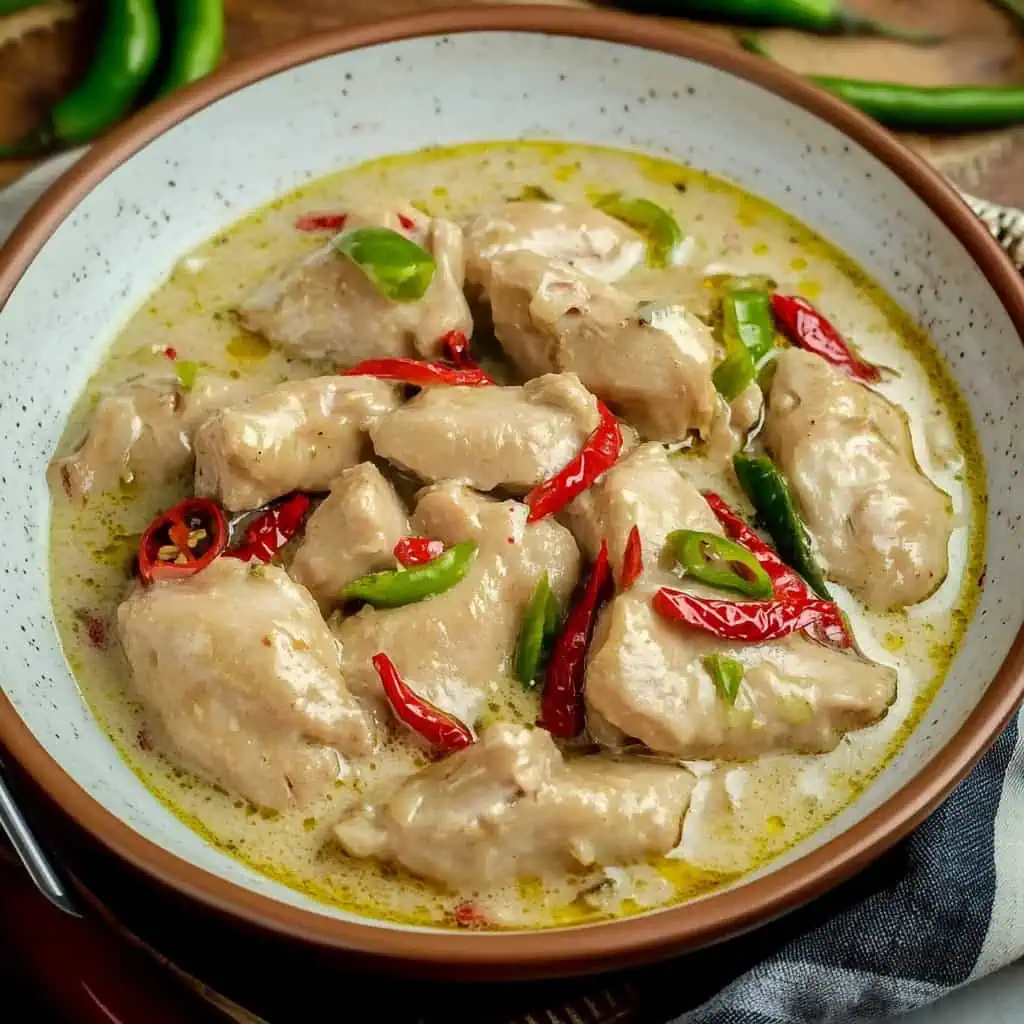









Comments
No Comments